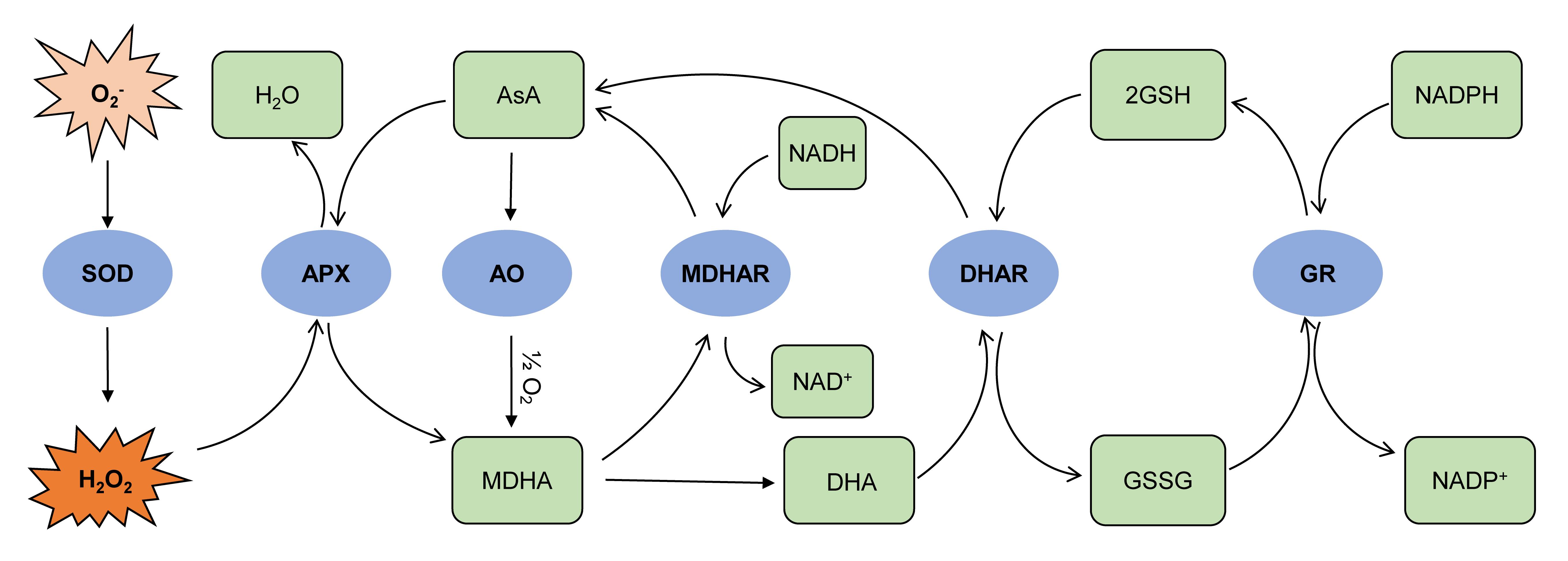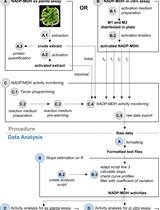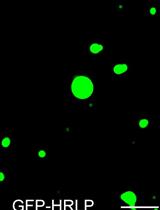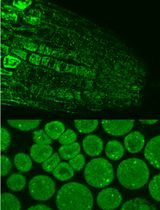- EN - English
- CN - 中文
High Throughput Analyses of Ascorbate-turnover Enzyme Activities in Rice (Oryza sativa L.) Seedlings
水稻幼苗抗坏血酸转化酶活性的高通量分析
发布: 2021年10月20日第11卷第20期 DOI: 10.21769/BioProtoc.4190 浏览次数: 4173
评审: Agnieszka ZienkiewiczAyelign M. AdalLifeng Liu
Abstract
Ascorbate (Vitamin C) fulfills various functions in plant photosynthesis and abiotic stress tolerance. The four key enzymes involved in the ascorbate-turnover pathway are ascorbate peroxidase, ascorbate oxidase, monodehydroascorbate reductase, and dehydroascorbate reductase. Several reports have shown the pivotal roles of these enzymes in plant development and stress tolerance. Therefore, reliable and rapid assay protocols are required for researchers to investigate their enzymatic activities during plant development and stress responses. Previously published methods for analyzing these enzymatic activities rely on cuvette spectrophotometers, which can only handle one sample per test, leading to a prolonged investigation. In this protocol, we employed a 96-well microplate reader to analyze at least eight samples with two technical replicates simultaneously. We analyzed two rice (Oryza sativa L.) genotypes with distinct ascorbate oxidase and dehydroascorbate reductase activities to demonstrate the assay process, including plant growth, sample preparation, reaction setup, and data analysis. Our protocol provides a high throughput method for investigating ascorbate turnover-related enzymatic activities in plants.
Keywords: Ascorbic acid (抗坏血酸)Background
L-Ascorbic acid (AsA, vitamin C) is the most abundant water-soluble antioxidant involved in plant photosynthesis, hormone biosynthesis, and abiotic stress tolerance (Gallie, 2012). In photosynthesis, AsA functions as the redox state regulator of photosynthetic electron carriers through ascorbate peroxidase (APX, EC 1.11.1.11) (Smirnoff and Wheeler, 2000). Ascorbate oxidase (AO, EC 1.10.3.3) catalyzes the oxidation of AsA to monodehydroascorbic acid (MDHA), which further disproportionate into dehydroascorbic acid (DHA) and AsA. MDHA and DHA can be recycled into AsA by monodehydroascorbate reductase (MDHAR, EC 1.6.5.4) and dehydroascorbate reductase (DHAR, EC 1.8.5.1), respectively (Figure 1). The turnover of AsA plays an essential role in abiotic stress tolerance in plants. Over-expressing an APX gene in sweet potato (Ipomoea batatas) conferred tolerance to salt, oxidative, and chilling stresses (Lim et al., 2007; Yan et al., 2016). Similarly, over-expressing an MDHAR gene in tomato plants increased the tolerance to chilling stress (Stevens et al., 2008). Moreover, Johnston et al. (2015) identified the roles of plant MDHAR in the mediation of 2,4,6-trinitrotoluene (TNT) toxicity. Wu et al. (2017) reported that iron toxicity tolerance in rice is associated with higher AO activity and lower DHAR activity. Due to the pivotal relevance in plant development and stress tolerance, reliable and rapid assay protocols are required for investigating the roles of these AsA-turnover enzymes in plants under various conditions. An AO activity assay in Tobacco (Nicotiana tabacum L.) was reported by Pignocchi et al. (2003) using a photospectrometric method to monitor the AsA oxidation rate indicated by the decrease of absorbance at 265 nm. For APX activity assay, Das et al. (2015) measured the H2O2-mediated oxidation of AsA by analyzing the absorbance at 290 nm using a spectrophotometer. MDHAR activity in spinach was determined by Hossain et al. (1984), in which they measured the oxidation of NADH through monitoring the decrease of absorbance at 340 nm. For DHAR activity assay, Stahl et al. (1983) reported a protocol using a spectrophotometric method to examine the generation of AsA. These protocols typically employed spectrophotometers and cuvettes to monitor absorbance change at a specific wavelength, only measuring one sample per run leading to the prolonged investigation. To overcome the limitations of low throughput in previously reported protocols, we developed a microplate reader-based method capable of measuring more than eight samples with technical replicates in one test. Our protocol can also be adapted for investigating ascorbate turnover-related enzymes in other plant species.

Figure 1. Ascorbate-turnover pathway and ascorbate-glutathione cycle. In the chloroplast, SOD scavenges O2- produced in PSII to form O2 and H2O2 molecules. APX mediates the scavenging of H2O2 with AsA as the electron donor, leading to the generation of MDHA. MDHA is also generated through the oxidation of AsA mediated by AO. MDHA further involves two distinct processes: (i) being reduced back to AsA through MDHAR with NADH as the electron donor, and (ii) being dissociated to generate DHA. DHAR mediates the reduction of DHA to AsA with two molecules of GSH as the electron donor. GR regulates the reduction of GSSG to GSH with NADPH as the electron donor. O2-, superoxide; SOD, superoxide dismutase; H2O2, hydrogen peroxide; APX, ascorbate peroxidase; AsA, ascorbic acid/ascorbate; AO, ascorbate oxidase; MDHA, monodehydroascorbate; MDHAR, monodehydroascorbate reductase; NADH/NAD+, nicotinamide adenine dinucleotide; DHA, dehydroascorbate; DHAR, dehydroascorbate reductase; GSH, glutathione; GSSG, glutathione disulfide; GR, glutathione reductase; NADPH/NADP+, nicotinamide adenine dinucleotide phosphate.
Materials and Reagents
Plant materials
Rice seedlings of IR29 and FL483 used in this protocol were described in our previous publication (Wu et al., 2017). FL483 is a recombinant inbred line derived from the cross between IR29 (Oryza sativa L., ssp. indica) and Pokkali (ssp. indica). IR29 and FL483 showed contrasting AO and DHAR activities, further presented in the Data analysis section.
Chemicals and reagents
L-(+)-Ascorbic acid, C6H8O6 (Alfa Aesar, catalog number: A15613), store at 2-8°C
Ascorbate oxidase, Cucurbita sp. (Merck, catalog number: 189724), store at -20 °C
Bovine serum albumin, BSA (Sigma-Aldrich, catalog number: 05470); store at 2-8°C
Bradford reagent (Sigma-Aldrich, catalog number: B6916); store at 2-8°C
Dehydro-L-(+)-ascorbic acid dimer, C12H12O12 (Sigma-Aldrich, catalog number: D8132), store at -20°C
EDTA disodium salt 2-hydrate, C10H14N2Na2O8·2H2O (PanReac AppliChem, catalog number: A2937), store at room temperature (RT)
L-Glutathione reduced, C10H17N3O6S (Sigma-Aldrich, catalog number: G4251), store at 2-8°C
Glycerol (Merck, catalog number: G5516-100ML), store at RT
Hydrogen chloride, HCl (Carl Roth, catalog number: 7476.1), store at RT
Hydrogen peroxide, H2O2 (Merck, catalog number: 386790-100ML), store at 2-8°C in the dark
Magnesium chloride hexahydrate, MgCl2·6H2O (Sigma-Aldrich, catalog number: M9272), store at 2-8°C
β-Nicotinamide adenine dinucleotide, reduced disodium salt hydrate, NADH (Sigma-Aldrich, catalog number: N8129), store at -20°C
Potassium phosphate dibasic, K2HPO4 (Sigma-Aldrich, catalog number: P3786), store at RT
Potassium phosphate monobasic, KH2PO4 (Sigma-Aldrich, catalog number: P0662), store at RT
Sodium chloride, NaCl (Sigma-Aldrich, catalog number: 31434), store at RT
Sodium phosphate monobasic monohydrate, NaH2PO4·H2O (Sigma-Aldrich, catalog number: S9638), store at RT
Sodium phosphate dibasic dehydrate, Na2HPO4 (Sigma-Aldrich, catalog number: 71643), store at RT
Tris ultrapure, C4H11NO3 (PanReac AppliChem, catalog number: A1086), store at RT
Fertilizer for rice plants (ICL/SF, Peter Excel CalMag Grower, catalog number: 2152), store at RT
Artificial soil for rice growth (see Table 2 in Recipes)
AO extraction buffer for soluble fraction (see Recipes), store at RT
AO extraction buffer for ionically bound fraction (see Recipes), store at RT
AO assay buffer (see Recipes), store at RT
APX/MDHAR extraction buffer (see Recipes), prepare fresh
APX assay buffer (see Recipes), prepare fresh
AO from Cucurbita sp. enzyme solution (see Recipes), store at -20°C
MDHAR assay buffer (see Recipes), prepare fresh
DHAR extraction buffer (see Recipes), store at RT
DHAR assay buffer (see Recipes), store at RT
Consumables
Pipette tips 0.1-10 µl (Eppendorf, epT.I.P.S.® Standard, catalog number: 0030000811)
Pipette tips 2-200 µl (Eppendorf, epT.I.P.S.® Standard, catalog number: 0030000889)
Pipette tips 100-1,000 µl (Eppendorf, epT.I.P.S.® Standard, catalog number: 0030000927)
Centrifuge tubes 1.5 ml (Eppendorf, Safe-Lock Tubes, catalog number: 0030120086)
Centrifuge tubes 2.0 ml (Eppendorf, Safe-Lock Tubes, catalog number: 0030120094)
Centrifuge tubes 50 ml (Corning, Falcon® Tubes, catalog number: 352070)
Filter paper (Schleicher and Schuell, catalog number: 311609)
UV-transparent 96-well microplate (Greiner Bio-One, UV-Star® Microplate, catalog number: 655801)
Microplate (Greiner Bio-One, 96 well Microplate, catalog number: 655101)
Serological pipet 5 ml (Eppendorf, Serological Pipets, catalog number: 0030127714)
Serological pipet 25 ml (Eppendorf, Serological Pipets, catalog number: 0030127730)
Serological pipet 50 ml (Eppendorf, Serological Pipets, catalog number: 0030127749)
Parafilm (Bemis, Parafilm M, catalog number: 2910057)
PCR strips (Biozym, PCR SingleCap 8er-SoftStrips 0.2 ml, catalog number: 710970)
Petri dishes (Greiner Bio-One, 100 × 20 mm, catalog number: 664102)
Reservoir (Corning, Axygen® 25 ml disposable, catalog number: RES-V-25)
Plant growth pots, 2 L (Nitsch, round pots, catalog number: 503402)
Holding trays for plant growth (Hermann Meyer, catalog number: 749651)
Equipment
Note: Other equipment models with similar functions, for example, microplate reader with absorbance measurement capabilities covering the spectral range of 265-595 nm, centrifuge with cooling function, multichannel pipettes, can also be used instead of the models listed. In this protocol, we described the assays of rice shoot samples, which require pestle and mortar for grinding. For smaller amounts of tissues, researchers can also use 2 ml centrifuge tubes and a tissue grinder for sample preparation.
-80°C freezer (Thermo Scientific, TSX ULT freezer, catalog number: TSX70086V)
Centrifuge with cooling function (Eppendorf, Centrifuge 5425R, catalog number: 5406000216)
Lab incubator (Memmert, Universal oven, catalog number: UN110m)
Analytical lab balance (Sartorius, 1702 analytical balance, catalog number: 05771)
Benchtop pH meter (Xylem Analytics, WTWTM inolab® 7110, catalog number: 9920090)
Ice bucket
Lab vortex mixer (Scientific Industries, Vortex-Genie 2, catalog number: SI-0236)
Magnetic stirrer (IKA, RH basic 2, catalog number: 0003339000)
Pipette controller (Eppendorf, Easypet 3, catalog number: 4430000018)
Multichannel pipette 0.5-10 µl (Eppendorf, Research®plus, catalog number: 3125000010)
Multichannel pipette 10-100 µl (Eppendorf, Research®plus, catalog number: 3125000036)
Pipette 2-20 µl (Eppendorf, Research®plus, catalog number: 3123000039)
Pipette 100-1,000 µl (Eppendorf, Research®plus, catalog number: 3123000063)
Microplate reader (TECAN; Infinite® 200 Pro M Plex, catalog number: INF-MPLEX)
Volumetric flasks 100 ml (Merck, Duran®, catalog number: DWK213722473)
Volumetric flasks 250 ml (Merck, Duran®, catalog number: DWK213723675)
Volumetric flasks 500 ml (Merck, Duran®, catalog number: DWK213724474)
Laboratory bottles 100 ml with screw cap and pouring ring (Merck, Duran®, catalog number: Z305170)
Laboratory bottles 250 ml with screw cap and pouring ring (Merck, Duran®, catalog number: Z305189)
Laboratory bottles 500 ml with screw cap and pouring ring (Merck, Duran®, catalog number: Z305197)
Pestle and mortar (Fisher Scientific, Haldenwanger 55-2, catalog number: 15292519)
Climate-controlled glasshouse
Software
Microplate reader i-controlTM (TECAN, https://lifesciences.tecan.com)
Microsoft Excel (Microsoft, https://www.microsoft.com/en-ww/microsoft-365/excel)
Procedure
文章信息
版权信息
© 2021 The Authors; exclusive licensee Bio-protocol LLC.
如何引用
Wu, L. B., Feng, Y., Zeibig, F., Alam, M. S. and Frei, M. (2021). High Throughput Analyses of Ascorbate-turnover Enzyme Activities in Rice (Oryza sativa L.) Seedlings. Bio-protocol 11(20): e4190. DOI: 10.21769/BioProtoc.4190.
分类
植物科学 > 植物生物化学 > 蛋白质 > 活性
生物化学 > 蛋白质 > 活性
您对这篇实验方法有问题吗?
在此处发布您的问题,我们将邀请本文作者来回答。同时,我们会将您的问题发布到Bio-protocol Exchange,以便寻求社区成员的帮助。
Share
Bluesky
X
Copy link













